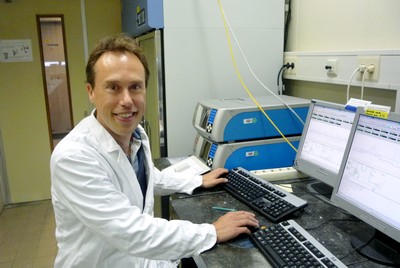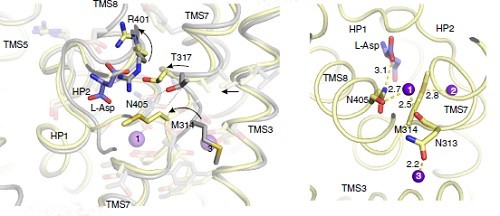Molecular pump reveals its secrets
Our cells use all kinds of proteins to import useful substances from their environment. These protein pumps are powered by a stream of particles, often sodium ions, that work a bit like water turning a water wheel. How this really works was shrouded in mystery, but University of Groningen biologists have now solved the puzzle. They published their findings in the journal Nature Communications on 10 November.
It’s in all the biology textbooks: transport across a cell membrane is powered by a difference in the concentration of particles inside and outside the cell. The concentration of sodium ions is much higher outside the cell than it is inside, whereas the reverse is true for potassium. But how exactly this worked was a mystery, says University of Groningen Professor of Biochemistry Dirk Slotboom.

‘What we did know’, he explains, ‘was that it took three sodium ions to import one molecule of aspartate, an important building block for cells. But nobody could figure out how the transport protein did this.’ It was clear that the transport of sodium and aspartate was linked. ‘If sodium could enter the cell on its own, the concentration difference would dissipate. And if aspartate could be transported without sodium, it would be able to move out of the cells as well.’
Crystal
Slotboom and his colleagues decided to study the mechanism that transports sodium and aspartate. To do this, they needed a detailed 3D structure of the protein, both with and without the sodium and aspartate. Such a structure is produced by X-ray crystallography, and this technique involves growing crystals from the protein. The quality of the crystal determines the level of detail. ‘This has been done in the past, but the structure was of a fairly poor resolution, so you couldn’t see the sodium ions.’
There are lots of variants in different cells of the transport protein that Slotboom and his colleague were studying. They therefore looked for a variant that would provide better quality crystals. This was a long process of trial and error, but it eventually yielded a result: structures of the protein with and without sodium and aspartate. ‘We therefore had two points in the transport process, the empty and the full protein. We then used simulations to calculate the steps in between.’

This revealed the mechanism that the transport protein is using. In its empty configuration, the protein has no affinity for aspartate and only a very weak affinity for sodium. But once the first sodium ion is bound, the structure changes and attracts a second sodium ion. This again changes the structure, and now a high affinity binding site for aspartate appears. ‘Once the aspartate is bound, a binding place for the third and final sodium ion forms’, Slotboom enthusiastically explains.
The final change in the structure of the transport protein takes place once the third ion is bound. ‘A kind of lid is closed: you could say the outside door is closed. Then the door to the inside opens.’ The third sodium ion is bound very weakly, so it comes away easily. This triggers the release of the aspartate, and subsequently the other two sodium ions. The inner door closes, the outer door opens and the process is ready to be repeated.
It is an elegant system, says Slotboom: ‘All of the steps are needed for the transport: aspartate can only bind after two sodium ions are attached to the protein, but the third sodium ion is needed to close the outside door. And the weak binding of the third ion facilitates the release of the aspartate.’ This type of transport protein is present in all kinds of cells and performs important functions. Detailed knowledge of the mechanism that operates them could help block vital transport systems in harmful bacteria, for example. But that is a different research project.
Reference: Albert Guskov, Sonja Jensen, Ignacio Faustino, Siewert J. Marrink & Dirk Jan Slotboom: Coupled binding mechanism of three sodium ions and aspartate in the glutamate transporter homologue GltTk . Nature Communications, 10 November 2016, doi 10.1038/ncomms13420
| Last modified: | 11 November 2016 3.38 p.m. |
More news
-
21 November 2024
Dutch Research Agenda funding for research to improve climate policy
Michele Cucuzzella and Ming Cao are partners in the research programme ‘Behavioural Insights for Climate Policy’
-
13 November 2024
Can we live on our planet without destroying it?
How much land, water, and other resources does our lifestyle require? And how can we adapt this lifestyle to stay within the limits of what the Earth can give?
-
13 November 2024
Emergentie-onderzoek in de kosmologie ontvangt NWA-ORC-subsidie
Emergentie in de kosmologie - Het doel van het onderzoek is oa te begrijpen hoe ruimte, tijd, zwaartekracht en het universum uit bijna niets lijken te ontstaan. Meer informatie hierover in het nieuwsbericht.

